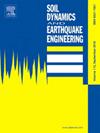Seismic evaluation of nuclear structures under structure-soil-structure interaction: Effects of ray-tracing wave propagation and damping calibration
IF 4.2
2区 工程技术
Q1 ENGINEERING, GEOLOGICAL
引用次数: 0
Abstract
The adjacent distribution of different nuclear structures is a common engineering scenario. Since the Fukushima nuclear accident and with rapid advancements in hardware computational capabilities, the local seismic behavior resulting from the interactions between structures and layered soils is being revisited, with potential to become a crucial component of evaluation refinement. The domain reduction method characterizes the relative spatial layouts of structures and surrounding geology, capturing their nonlinear coupling behavior in an exogenous wave field. This study focuses on developing an efficient theoretical model and corresponding algorithmic framework that integrates the partitioned pattern of system matrices, calibration of damping parameters, and batch computation of seismic forces, aided by parallelization and GPU acceleration. The parametric study is conducted for typical scenarios and modular structures, and the following conclusions are drawn. Structure–soil–structure interactions potentially have adverse effects on seismic safety, as exemplified by floor response spectra. Adjustments to the design elevation differences may lead to change in the peak values of vertical floor spectra of nearly 45 %. Softer inter-building inclusions have damping effects, whereas harder inclusions increase the peak values. A high-accuracy ray-tracing wavefields perspective for the seismic evaluation of specific structure adjacency and complex sites is supported via the procedural strategy.
结构-土-结构相互作用下核结构的地震评价:射线追踪波传播和阻尼标定的影响
不同核结构的相邻分布是一种常见的工程场景。自福岛核事故以来,随着硬件计算能力的快速发展,由结构和层状土壤之间相互作用引起的局部地震行为正在重新审视,有可能成为评估改进的关键组成部分。域约简方法表征了结构和周围地质的相对空间布局,捕捉了它们在外源波场中的非线性耦合行为。本研究的重点是开发一个高效的理论模型和相应的算法框架,该模型集成了系统矩阵的划分模式、阻尼参数的校准和地震力的批量计算,并辅以并行化和GPU加速。对典型场景和模块化结构进行了参数化研究,得出以下结论:结构-土-结构相互作用可能对地震安全产生不利影响,如楼板反应谱所示。调整设计高差可导致垂直楼板光谱峰值变化近45%。较软的建筑物间夹杂物具有阻尼作用,而较硬的夹杂物则增加峰值。通过程序策略,为特定结构邻接和复杂地点的地震评价提供了高精度射线追踪波场视角。
本文章由计算机程序翻译,如有差异,请以英文原文为准。
求助全文
约1分钟内获得全文
求助全文
来源期刊

Soil Dynamics and Earthquake Engineering
工程技术-地球科学综合
CiteScore
7.50
自引率
15.00%
发文量
446
审稿时长
8 months
期刊介绍:
The journal aims to encourage and enhance the role of mechanics and other disciplines as they relate to earthquake engineering by providing opportunities for the publication of the work of applied mathematicians, engineers and other applied scientists involved in solving problems closely related to the field of earthquake engineering and geotechnical earthquake engineering.
Emphasis is placed on new concepts and techniques, but case histories will also be published if they enhance the presentation and understanding of new technical concepts.
 求助内容:
求助内容: 应助结果提醒方式:
应助结果提醒方式:


